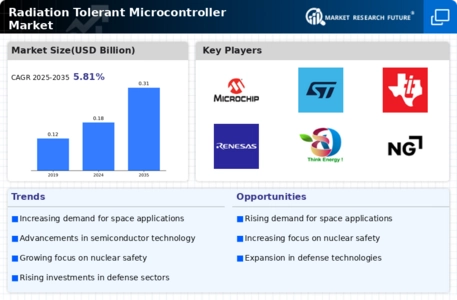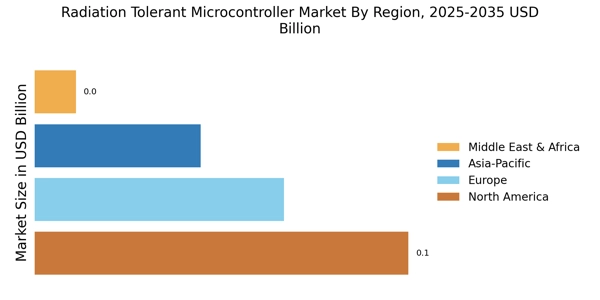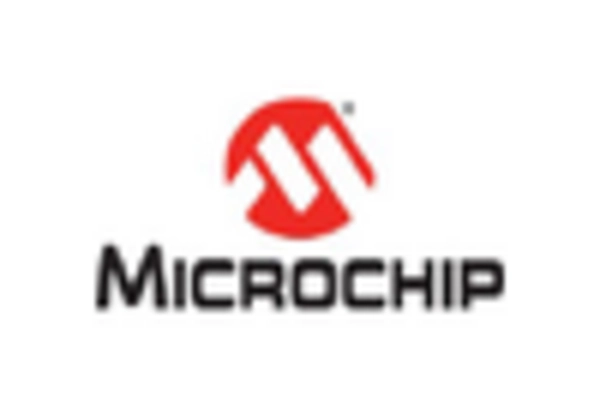Expansion of Nuclear Power Generation
The Radiation Tolerant Microcontroller Market is also benefiting from the expansion of nuclear power generation. As countries seek to diversify their energy sources, nuclear power is gaining traction as a reliable and low-carbon option. This shift necessitates the use of radiation tolerant microcontrollers in various applications, including monitoring systems and control units within nuclear facilities. The market for nuclear power is projected to grow, with estimates suggesting an increase in installed capacity by approximately 10% over the next decade. Consequently, the demand for microcontrollers that can withstand radiation exposure is likely to rise, further propelling the Radiation Tolerant Microcontroller Market.
Growing Space Exploration Initiatives
The Radiation Tolerant Microcontroller Market is experiencing a surge in demand due to the increasing number of space exploration initiatives. Governments and private entities are investing heavily in space missions, which require robust and reliable microcontrollers capable of withstanding harsh radiation environments. For instance, the number of satellite launches has seen a significant rise, with projections indicating that over 100 satellites could be launched annually in the coming years. This trend necessitates the integration of radiation tolerant microcontrollers to ensure the functionality and longevity of space equipment. As a result, manufacturers are focusing on developing advanced microcontrollers that can operate effectively in extreme conditions, thereby driving growth in the Radiation Tolerant Microcontroller Market.
Increased Focus on Defense Applications
The Radiation Tolerant Microcontroller Market is witnessing heightened interest from defense sectors worldwide. Military applications often require equipment that can endure extreme conditions, including radiation exposure from nuclear events or high-altitude operations. As defense budgets increase, there is a growing emphasis on developing advanced technologies that incorporate radiation tolerant microcontrollers. Reports indicate that defense spending is expected to rise by 3% annually, leading to increased investments in research and development of radiation resistant technologies. This trend is likely to bolster the Radiation Tolerant Microcontroller Market as defense contractors seek reliable solutions for mission-critical systems.
Rising Demand for Internet of Things (IoT) Devices
The Radiation Tolerant Microcontroller Market is experiencing growth due to the rising demand for Internet of Things (IoT) devices. As IoT applications expand into sectors such as agriculture, healthcare, and smart cities, the need for reliable microcontrollers that can operate in diverse environments becomes critical. In particular, IoT devices deployed in remote or hazardous locations may be exposed to radiation, necessitating the use of radiation tolerant microcontrollers. Market analysts predict that the IoT market will grow significantly, with estimates suggesting a compound annual growth rate of over 25% in the next five years. This trend is likely to drive the Radiation Tolerant Microcontroller Market as manufacturers respond to the increasing need for resilient and dependable microcontroller solutions.
Technological Advancements in Microcontroller Design
The Radiation Tolerant Microcontroller Market is being propelled by ongoing technological advancements in microcontroller design. Innovations in semiconductor materials and fabrication techniques are enabling the development of microcontrollers that not only meet radiation tolerance requirements but also offer enhanced performance and energy efficiency. The introduction of new design methodologies, such as system-on-chip (SoC) architectures, is allowing for more compact and powerful solutions. As the demand for high-performance electronics continues to grow across various sectors, including aerospace and automotive, the Radiation Tolerant Microcontroller Market is likely to benefit from these advancements, leading to increased adoption of radiation tolerant solutions.

















Leave a Comment